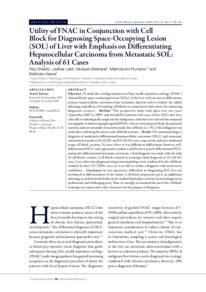وثيقة
Utility of FNAC in conjunction with cell block for diagnosing space-occupying lesion (SOL) of liver with emphasis on differentiating hepatocellular carcinoma from metastatic SOL : analysis of 61 cases.
المعرف
DOI 10.5001/omj.2016.26
المساهمون
الناشر
Sheefa, Haq, Lata, Jadhav, Basharat, Mubeen, Rumana, Makhdoomi, & Veena, Malhotra (2016). Utility of FNAC in conjunction with cell block for diagnosing space-occupying lesion (SOL) of liver with emphasis on differentiating hepatocellular carcinoma from me
ميلادي
2016-03
اللغة
الأنجليزية
الملخص الإنجليزي
Objectives: To study the cytological patterns of fine-needle aspiration cytology (FNAC) obtained from space-occupying lesions (SOLs) of the liver with an aim to differentiate primary hepatocellular carcinoma from metastatic deposits and to evaluate the added advantage and efficacy of studying cell blocks in conjunction with smears for enhancing diagnostic accuracy. Methods: This prospective study took place over two years (September 2007 to 2009) and included 61 patients with cases of liver SOLs that were clinically or radiologically suspicious for malignancy and who were referred for computed tomography or ultrasonography-guided FNAC. Smears were prepared from the aspirated material, and any remainder was used to make the cell block (n = 55). A final diagnosis was made after evaluating the smears and cell block sections. Results: On cytomorphology, a diagnosis of moderately differentiated hepatocellular carcinoma (HCC) and metastatic carcinoma was made in 10 (18.2%) and 25 (45.5%) cases, respectively, and were confirmed using cell block sections. In cases where it was difficult to differentiate between well-differentiated HCC and regenerative nodules, and between poorly differentiated HCC and poorly differentiated metastatic carcinoma, a final diagnosis was made with the help of cell blocks sections. Cell blocks assisted in reaching a final diagnosis in 16 (29.1%) cases. Cases that were diagnosed using cytomorphology were confirmed by the cell block method. In these 39 (70.9%) cases we were able to render a diagnosis with much more confidence. Conclusion: In our experience, difficulties in diagnosing SOL liver are attributed to differentiation of the tumor. Cell block preparation gives an additional advantage as architectural details can be studied that help to reach an accurate diagnosis in problematic and challenging cases. Thus, we strongly recommend the use of the cell block technique in conjunction with cytosmears for the purpose of diagnosis.
المجموعة
URL المصدر
قالب العنصر
مقالات الدوريات

